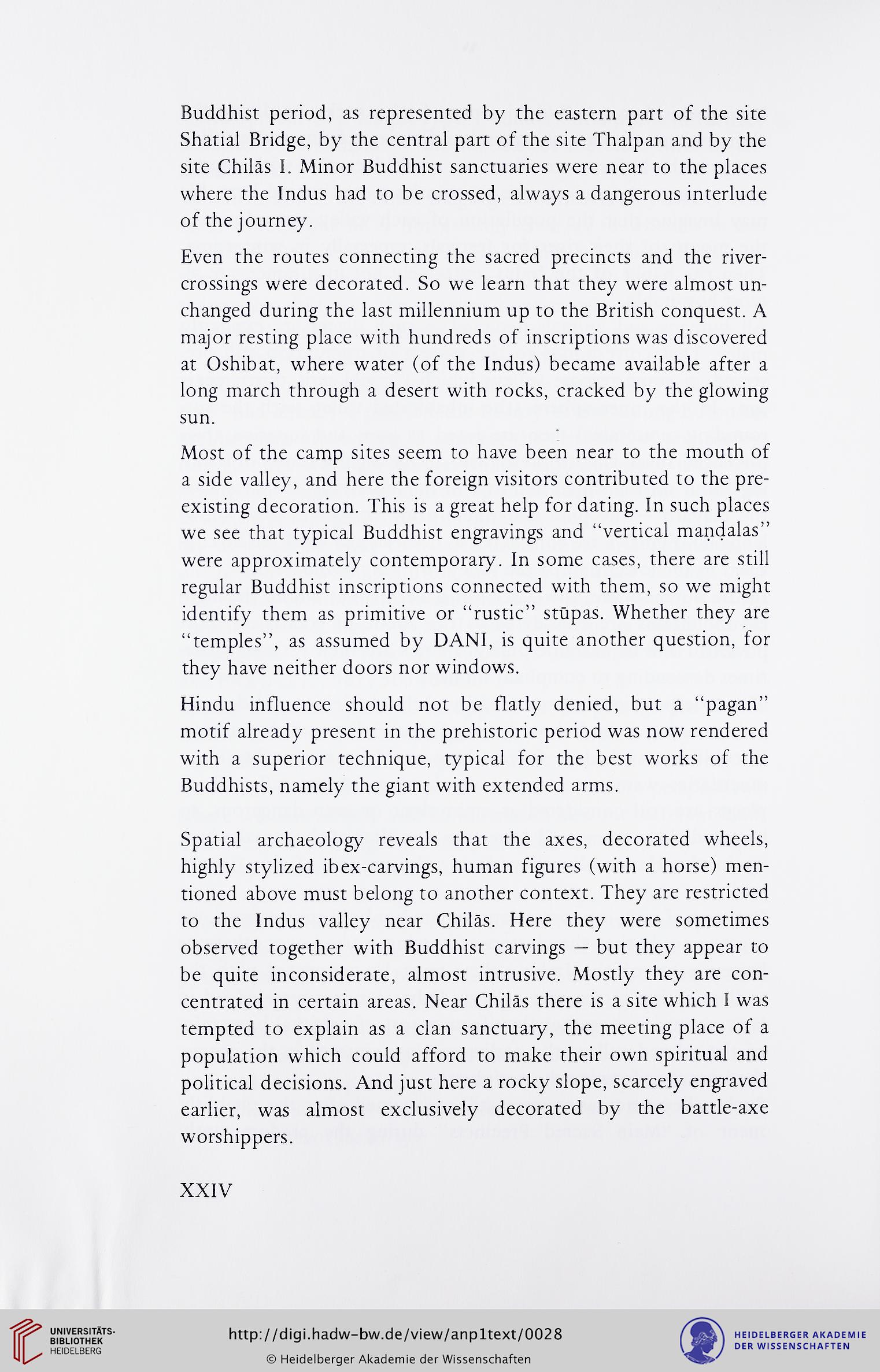Buddhist period, as represented by the eastern part of the site
Shatial Bridge, by the centra! part of the site Thalpan and by the
site Chilas !. Minor Buddhist sanctuaries were near to the places
where the Indus had to be crossed, always a dangerous interlude
of the journey.
Even the routes connecting the sacred precincts and the river-
crossings were decorated. So we learn that they were almost un-
changed during the last millennium up to the British conquest. A
major resting place with hundreds of inscriptions was discovered
at Oshibat, where water (of the Indus) became available after a
long march through a desert with rocks, cracked by the glowing
sun.
Most of the camp sites seem to have been near to the mouth of
a side valley, and here the foreign visitors contributed to the pre-
existing decoration. This is a great help for dating. In such places
we see that typical Buddhist engravings and "vertical mandalas"
were approximately contemporary. In some cases, there are still
regular Buddhist inscriptions connected with them, so we might
identify them as primitive or "rustic'* stupas. Whether they are
"temples", as assumed by DANI, is quite another question, for
they have neither doors nor windows.
Hindu influence should not be flatly denied, but a "pagan"
motif already present in the prehistoric period was now rendered
with a superior technique, typical for the best works of the
Buddhists, namely the giant with extended arms.
Spatial archaeology reveals that the axes, decorated wheels,
highly stylized ibex-carvings, human figures (with a horse) men-
tioned above must belong to another context. They are restricted
to the Indus valley near Chilas. Here they were sometimes
observed together with Buddhist carvings — but they appear to
be quite inconsiderate, almost intrusive. Mostly they are con-
centrated in certain areas. Near Chilas there is a site which I was
tempted to explain as a clan sanctuary, the meeting place of a
population which could afford to make their own spiritual and
political decisions. And just here a rocky slope, scarcely engraved
earlier, was almost exclusively decorated by the battle-axe
worshippers.
XXIV
Shatial Bridge, by the centra! part of the site Thalpan and by the
site Chilas !. Minor Buddhist sanctuaries were near to the places
where the Indus had to be crossed, always a dangerous interlude
of the journey.
Even the routes connecting the sacred precincts and the river-
crossings were decorated. So we learn that they were almost un-
changed during the last millennium up to the British conquest. A
major resting place with hundreds of inscriptions was discovered
at Oshibat, where water (of the Indus) became available after a
long march through a desert with rocks, cracked by the glowing
sun.
Most of the camp sites seem to have been near to the mouth of
a side valley, and here the foreign visitors contributed to the pre-
existing decoration. This is a great help for dating. In such places
we see that typical Buddhist engravings and "vertical mandalas"
were approximately contemporary. In some cases, there are still
regular Buddhist inscriptions connected with them, so we might
identify them as primitive or "rustic'* stupas. Whether they are
"temples", as assumed by DANI, is quite another question, for
they have neither doors nor windows.
Hindu influence should not be flatly denied, but a "pagan"
motif already present in the prehistoric period was now rendered
with a superior technique, typical for the best works of the
Buddhists, namely the giant with extended arms.
Spatial archaeology reveals that the axes, decorated wheels,
highly stylized ibex-carvings, human figures (with a horse) men-
tioned above must belong to another context. They are restricted
to the Indus valley near Chilas. Here they were sometimes
observed together with Buddhist carvings — but they appear to
be quite inconsiderate, almost intrusive. Mostly they are con-
centrated in certain areas. Near Chilas there is a site which I was
tempted to explain as a clan sanctuary, the meeting place of a
population which could afford to make their own spiritual and
political decisions. And just here a rocky slope, scarcely engraved
earlier, was almost exclusively decorated by the battle-axe
worshippers.
XXIV




